Locomotives of the Lancashire and Yorkshire Railway
Locomotives of the Lancashire and Yorkshire Railway. The Lancashire and Yorkshire Railway locomotive works were originally at Miles Platting, Manchester. From 1889 they were at Horwich.
Constituent companies
The L&YR came into being in 1847 when the Manchester and Leeds Railway changed its name. Locomotives added to its stock before that date came from the:
- Manchester and Bolton Railway (amalgamated 18 August 1846)
- North Union Railway (a share acquired 31 December 1846)
As the L&YR, locomotives were taken into stock from the:
- Preston & Wyre Railway, Harbour and Dock Co. (vested L&Y (two thirds) and L&NWR (one third) 28 July 1849)
- Blackburn, Darwen and Bolton Railway (amalgamated jointly with the East Lancashire Railway 1 January 1858)
- Liverpool, Crosby and Southport Railway (purchased 14 June 1855)
- Preston and Longridge Railway (taken over jointly with the L&NWR 17 June 1867)
- Blackburn and Preston Railway (amalgamated with the East Lancashire 3 August 1846)
- East Lancashire Railway (amalgamated as a separate division 13 August 1859, loco stocks amalgamated 17 March 1875 by adding 600 to East Lancs numbers.)
- Blackpool and Lytham Railway (amalgamated with the Preston and Wyre Joint Railway (L&Y/L&NW Joint)in 1871/2)
- West Lancashire Railway (amalgamated 15 July 1897)
- Liverpool, Southport and Preston Junction Railway (amalgamated with the West Lancashire December 1888 and with the L&Y 15 July 1897)
The Miles Platting era
William Jenkins (Indoor) 1845–1867 & William Hurst (Outdoor) 1846–1854
Although Jenkins was the Locomotive Superintendent the early years of this period saw Hawkshaw specifying the locomotives. As Hawkshaw was not a locomotive engineer the resultant locomotives were not of the best and were hopelessly outdated long before they were withdrawn. Hurst left to join the North British Railway in 1854 and Jenkins continued on his own.
| No. of 1st built | Type | Quantity | Manufacturer | Date | Driving wheel diameter | Notes |
|---|---|---|---|---|---|---|
| 54 | 0-4-0 | 37 | Wm. Fairbairn (22) Edward Bury (15) | 1847–49 | 4 ft 9 in | Between 10 and 13 rebuilt as 0-4-2 |
| 53 | 2-2-2 | 43 | L&YR Miles Platting (26) Wm. Fairbairn (17) | 1847–49 | 5 ft 9 in | Almost all (69) rebuilt 1867-72 as 2-4-0 |
| 62 | 2-2-2 | 10 | L&YR Miles Platting (6) Wm. Fairbairn (4) | 1847–49 | 5 ft 6 in | |
| 112 | 2-2-2 | 29 | Bury, Curtis & Kennedy | 1849 | 5 ft 10 in | |
| 202 | 0-6-0 | 2 | E. B. Wilson & Co. | 1849 | 4 ft 9 in | |
| 163 | 0-4-2 | 35 | L&YR Miles Platting (26) Wm. Fairbairn (9) | 1849–70 | 4 ft 9 in | Two rebuilt in 1869 as 0-6-0 |
| 217 | 0-6-0 | 12 | L&YR Miles Platting | 1854–55 | 5 ft 0 in | |
| 141 | 0-6-0 | 149 | L&YR Miles Platting | 1855–70 | 4 ft 10 in | Between 1878 and 1887 34 were rebuilt as 0-6-0ST, 18 as 0-6-2T and 3 as 0-4-4T |
| 119 | 0-6-0ST | 11 | L&YR Miles Platting | 1855–67 | 4 ft 0 in | |
| 130 | 0-6-0ST | 26 | L&YR Miles Platting | 1856–71 | 5 ft 0 in | |
| 286 | 2-4-0 | 22 | L&YR Miles Platting | 1861–67 | 5 ft 9 in |
William Yates (Indoor) 1868–1875 & William Hurst (Outdoor) 1868–1875
Following the death of Jenkins responsibility passed to Yates as Indoor Superintendent and Hurst returned as the Outdoor Superintendent. Hurst retired in 1875 and Yates resigned. A disastrous fire at the Miles Platting works in 1873 led to the building of the new Horwich Works.
The official system of numbered classes was not introduced until 1919, therefore classes are listed here according to the number of the first locomotive built.
| No. of 1st built | Type | Quantity | Manufacturer | Date | Notes |
|---|---|---|---|---|---|
| 4 | 2-4-0 | 23 | L&YR Miles Platting (23) | 1870–75 | 6 ft 0 in wheels, 16×24-in cylinders |
| 2-4-0 | 4 | ELR Bury works (4) | 1873 | ||
| 456 | 2-4-0 | 10 | LNWR Crewe | 1873 | LNWR Newton Class |
| 63 | 2-4-0 | 10 | L&YR Miles Platting | 1875–76 | 6 ft 0 in wheels, 17×24-in cylinders |
| 103 | 2-4-0 | 1 | L&YR Miles Platting | 1875 | 5 ft 6 in wheels, 16×24-in cylinders |
| 90 | 0-6-0 | 62 | L&YR Miles Platting (62) | 1869–72 | |
| 0-6-0 | 10 | Kitson & Co. (10) | 1871 | ||
| 0-6-0 | 12 | Yorkshire Engine Co. (12) | 1875 | ||
| 413 | 0-6-0 | 86 | LNWR Crewe | 1871–74 | LNWR “DX” Class |
| 23 | 2-4-0ST | 1 | L&YR Miles Platting | 1868 | |
| 32 | 2-4-0ST | 25 | L&YR Miles Platting | 1868–74 | |
| 403 | 0-4-0ST | 5 | LNWR Crewe | 1872 | |
| 216 | 0-6-0ST | 45 | L&YR Miles Platting | 1868–75 | 4 ft 0 in wheels |
| 191 | 0-6-0ST | 6 | L&YR Miles Platting | 1873–74 | 5 ft 0 in wheels |
| 161 | 0-6-0ST | 23 | L&YR Miles Platting | 1872–78 | 4 ft 6 in wheels |
The Horwich era
Note: The class numbers below are those introduced by Hughes in 1919. Each can cover several similar varieties, e.g. all the non-superheated 0-8-0s are Class 30
William Barton Wright (1875–1886)
During this period the Horwich Works was under construction and apart from a few built at Miles Platting, engines came from outside manufacturers.
| No. of 1st built | Type | Quantity | Manufacturer | Date | LYR Class | LMS power classification | LMS nos. | Notes |
|---|---|---|---|---|---|---|---|---|
| 605 | 0-4-2 | 8 | Sharp, Stewart & Co. | 1876 | — | — | — | GNR class F2 diverted to L&YR |
| 629 | 4-4-0 | 18 | Sharp, Stewart & Co. (18) | 1880–81 | — | — | — | |
| 4-4-0 | 30 | Neilson & Co. (30) | 1883–84 | — | — | — | ||
| 4-4-0 | 20 | Kitson & Co. (20) | 1885 | — | — | — | ||
| 4-4-0 | 20 | Vulcan Foundry (20) | 1886 | — | — | — | ||
| 209 | 4-4-0 | 16 | Vulcan Foundry | 1887 | 2 | 1P | 10100–10101 | |
| 111 | 0-4-4T | 12 | Kitson & Co. (12) | 1877–78 | — | — | — | |
| 0-4-4T | 10 | Dübs & Co. (10) | 1878 | — | — | — | ||
| 0-4-4T | 10 | Neilson & Co. (10) | 1879 | — | — | — | ||
| 0-4-4T | 40 | Sharp, Stewart & Co. (40) | 1885–86 | — | — | — | ||
| 789 | 0-4-0ST | 4 | Manning, Wardle & Co. | 1882 | — | — | — | |
| 883 | 0-4-0ST | 2 | Black, Hawthorn & Co. | 1885 | — | — | — | |
| 885 | 0-4-0ST | 1 | Kitson & Co. | 1885 | — | — | — | |
| 72 | 0-6-0ST | 8 | L&YR Miles Platting | 1877 | — | — | — | Similar to Yates "161" class but with 4 ft 0 in wheels |
| 141 | 0-6-2T | 8 | Kitson & Co. | 1880–81 | 22 | 1F | 11600–11601 | |
| 243 | 0-6-2T | 14 | Kitson & Co. (14) | 1881 | 22 | 1F | 11602–11606 | |
| 0-6-2T | 40 | Dübs & Co. (40) | 1882–83 | 22 | 1F | 11607–11621 | ||
| 528 | 0-6-0 | 57 | Kitson & Co. (57) | 1876–80 | — | — | — | All converted to Class 23 saddle tanks (below) |
| 0-6-0 | 18 | Sharp, Stewart & Co. (18) | 1877 | — | — | — | All converted to Class 23 saddle tanks (below) | |
| 0-6-0 | 40 | L&YR Miles Platting (40) | 1878–81 | — | — | — | All converted to Class 23 saddle tanks (below) | |
| 0-6-0 | 45 | Vulcan Foundry (45) | 1880–83 | — | — | — | All converted to Class 23 saddle tanks (below) | |
| 0-6-0 | 50 | Beyer, Peacock & Co. (50) | 1881–82 | — | — | — | All converted to Class 23 saddle tanks (below) | |
| 0-6-0 | 20 | Kitson & Co. (20) | 1885 | — | — | — | All converted to Class 23 saddle tanks (below) | |
| 928 | 0-6-0 | 20 | Vulcan Foundry (20) | 1887 | 25 | 2F | 12015–12034 | |
| 0-6-0 | 30 | Beyer, Peacock & Co. (30) | 1887 | 25 | 2F | 12035–12064 |
John Audley Frederick Aspinall (1886–1899)
From 1889 Horwich Works was completed and from that time all engines were constructed there.
| No. of 1st built | Type | Quantity | Manufacturer | Date | LYR Class | LMS power classification | LMS nos. | Notes |
|---|---|---|---|---|---|---|---|---|
| 978 | 4-4-0 | 30 | Beyer, Peacock & Co. | 1888–89 | 2 (Aspinall) | 1P | 10102–10130 | |
| 1093 | 4-4-0 | 40 | Horwich Works | 1891–94 | 3 | 2P | 10150–10183 | 6 rebuilt with Superheater to become Class 4. One engine spent some time as a 4-cylinder compound. First 20 reused tenders from converted "568" class engines. |
| 1400 | 4-4-2 | 40 | Horwich Works | 1899–1902 | 7 | 2P | 10300–10339 | "High-Flyers." First 20 reused tenders from converted "568" class engines. |
| 1008 | 2-4-2T | 270 | Horwich Works | 1889–1901 | 5 | 2P | 10621–10869 | 26 rebuilt with Superheater to become Class 6 |
| 916 | 0-4-0ST | 3 | Vulcan Foundry | 1886 | 21 | — | 11200 | |
| 1153 | 0-4-0ST | 57 | Horwich Works | 1891–1910 | 21 | — | 11201–11257 | |
| Dot | 0-4-0WT | 8 | Beyer, Peacock & Co. (3) Horwich Works (5) | 1887-1901 | — | — | — | 18-inch gauge, for use at Horwich Works. |
| 0-6-0ST | 230 | Horwich Works | 1891–1900 | 23 | 2F | 11303–11532 | Rebuilds of "528" class tender engines | |
| 11 | 0-6-0 | 448 | Horwich Works | 1889–1918 | 27 | 3F | 12083–12467 | Many reused tenders from rebuilt "528" class engines. 63 rebuilt with Superheater to become Class 28 |
| 1351 | 0-6-0T | 20 | Horwich Works | 1897 | 24 | 2F | 11533–11546 | |
| 91 | 0-8-0 | 110 | Horwich Works | 1900–08 | 30 | 5F | 12700–12759 | Small boiler, 50 later rebuilt (see below) |
Henry Albert Hoy (1899–1904)
| No. of 1st built | Type | Quantity | Manufacturer | Date | LYR Class | LMS power classification | LMS nos. | Notes |
|---|---|---|---|---|---|---|---|---|
| 202 | 2-6-2T | 20 | Horwich Works | 1903–04 | 26 | 3F | 11700–11716 | |
| 392 | 0-8-0 | 21 | 1903 | 30 | First was experimental rebuild of "91" class, rest new, all with corrugated cylindrical steel firebox. All rebuilt by Hughes (below). |
George Hughes (1904–1922)
| No. of 1st built | Type | Quantity | Manufacturer | Date | LYR Class | LMS power classification | LMS nos. | Notes |
|---|---|---|---|---|---|---|---|---|
| 4-4-0 | 6 | 1908–09 | 4 | 3P | 10190–10195 | Superheated. Rebuilds of Class 3 | ||
| 1506 | 4-6-0 | 20 | Horwich Works | 1908–09 | 8 | 3P | 10400–10404 | [1] 4-Cylinder, 15 rebuilt with superheaters (see below) |
| 1522 | 4-6-0 | 70 | Horwich Works | 1920–24 | 8 | 5P | 10405–10474 | [2] Superheated, 15 were rebuilds. |
| 1 | 0-2-2T | 2 | Kerr, Stuart & Co. | 1905 | — | — | — | [3] Railmotor locos. Withdrawn 1909 and replaced by following class. |
| 3 | 0-4-0T | 18 | Horwich & Newton Heath Works | 1906–11 | 1 | — | 10600–10617 | [4] Railmotor locos |
| 816 | 2-4-2T | 40 | Horwich Works | 1905–10 | 5 | 2P | 10870–10899 | [5] Belpaire firebox, 18 later superheated to become Class 6 |
| 18 | 2-4-2T | 64 | Horwich Works | 1911 | 6 | 3P | 10900–10954 | [6] Belpaire & Superheated, 44 were rebuilds of Class 5 |
| 1501 | 0-8-2T | 5 | Horwich Works | 1908 | 32 | 6F | 11800–11804 | [7] |
| 898 | 0-6-0 | 22 | Horwich Works | 1906–09 | 28 | 3F | 12515–12536 | [8] Superheated |
| 657 | 0-6-0 | 20 | Horwich Works | 1912 | 28 | 3F | 12537–12556 | [9] Belpaire & Superheated |
| 0-6-0 | 63 | 1913–22 | 28 | 4F | 12557–12619 | Belpaire & Superheated, rebuilds of Class 27 | ||
| 1452 | 0-8-0 | 11 | Horwich Works | 1906–07 | 30 (Hughes compound) | 5F | 12760–12770 | [10] 4-cylinder compound; first was rebuilt, rest new |
| 9 | 0-8-0 | 73 | Horwich Works | 1910–18 | 30 (Hughes) | 6F | 12771–12839 | [11] Large saturated boiler, with Belpaire firebox. 33 were rebuilds, 40 new. 4 later rebuilt with superheaters as Class 31. |
| 1546 | 0-8-0 | 15 | Horwich Works | 1912–21 | 31 | 7F | 12840–12994 | [12] Superheated Belpaire boiler. 115 were new builds, others were rebuilds of Class 30 0-8-0s. |
| 2-10-0 | not built | 1914 | 2-10-0 | A design for a heavy mineral loco, not constructed owing to the outbreak of war. | ||||
| (1684) | 4-6-4T | 10 | Horwich Works | 1924 | (none) | 5P | 11110–11119 | [13] Superheated. L&YR design introduced after grouping. Twenty more were ordered but were constructed as Class 8 4-6-0.[14] |
| 1629 | 2-8-0 | 27 | Kitson & Co. (1) R. Stephenson & Co. (5) Nasmyth, Wilson & Co. (2) North British Loco. Co. (19) | 1919 | — | — | — | [15] Robinson ROD 2-8-0 type. Hired from the government in November 1919, but transferred to GWR and LNWR March–June 1920. No L&YR numbers allocated |
| 1 | 1-AA-1 | 1 | Horwich Works | 1912 | — | — | — | [16] Electric locomotive |
| 2 | B | 1 | Horwich Works | 1917 | — | — | — | [15] Battery-Electric |
Notes on L&Y classes
The "number only" classes are those introduced by George Hughes in 1919 and shown in the L&YR working timetable appendix of 1921.[17] There is also a series of unofficial "letter and number" classes which was devised by the author R. W. Rush, and which has been copied by some other authors.[18]
Picture gallery
 Bank Hall Locomotive Shed on 20 June 1948: an ex-Lancashire & Yorkshire 'Pug' 0-4-0T No. 11246.
Bank Hall Locomotive Shed on 20 June 1948: an ex-Lancashire & Yorkshire 'Pug' 0-4-0T No. 11246.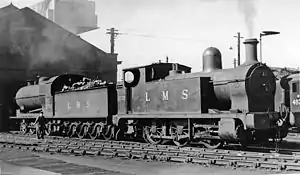 Bank Hall Locomotive Depot in 1948: two ex-Lancashire & Yorkshire engines, 1F 0-6-0T No. 11535 and Class 30 6F 0-8-0 No. 12782.
Bank Hall Locomotive Depot in 1948: two ex-Lancashire & Yorkshire engines, 1F 0-6-0T No. 11535 and Class 30 6F 0-8-0 No. 12782.
Preservation
Eight locomotives survive, these being:
| Image | Class | Type | L&Y No. | LMS No. | BR No. | Manufacturer | Serial Number | Date | Notes |
|---|---|---|---|---|---|---|---|---|---|
 |
Dot | 0-4-0ST | Wren | Wren | Wren | Beyer, Peacock & Co. | 2825 | 1887 | 18-inch gauge Horwich Works shunter; static display, National Railway Museum, York |
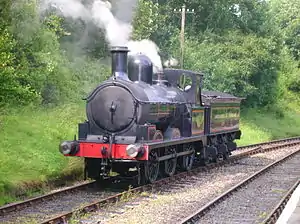 |
25 | 0-6-0 | 957 | 12044 | 52044 | Beyer, Peacock & Co. | 2840 | 1887 | Owned by 957 Bowers Trust, awaiting overhaul, last used on Keighley and Worth Valley Railway in January 2013 |
.jpg.webp) |
5 | 2-4-2T | 1008 | 10621 | 50621 | Horwich Works | 1 | 1889 | Static display, National Railway Museum, York |
 |
27 | 0-6-0 | 1300 | 12322 | 52322 | Horwich Works | 420 | 1895 | In regular use on preserved railways since 2009 |
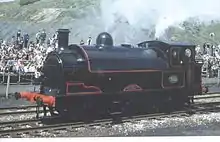 |
23 | 0-6-0ST | 752 | 11456 | — | Beyer, Peacock & Co. | 1989 | 1881 | Rebuilt as saddle tank in 1896; sold to coal industry 1937; owned by Lancashire and Yorkshire Railway Trust, restored to steam in public service at the East Lancashire Railway at Bury in early 2020. |
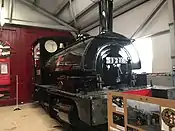 |
21 | 0-4-0ST | 68 | 11218 | 51218 | Horwich Works | 811 | 1901 | First preserved loco to arrive at Keighley and Worth Valley Railway in 1965, owned by Lancashire and Yorkshire Railway Trust, awaiting restoration at Keighley and Worth Valley Railway. |
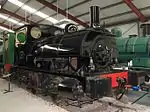 |
21 | 0-4-0ST | 19 | 11243 | — | Horwich Works | 1097 | 1910 | Sold by LMS to private industry, now owned by Lancashire and Yorkshire Railway Trust, on display at Ribble Steam Railway, in early 2020 temporarily relocated to the East Lancashire Railway at Bury and not necessarily on public display. |
| 0-4-0PM | 1 | Motor Rail | Petrol mechanical shunter no. 1 |
References
- Baxter 1982, p. 92.
- Baxter 1982, pp. 92–94.
- Baxter 1982, p. 87.
- Baxter 1982, pp. 87–88.
- Baxter 1982, p. 86.
- Baxter 1982, pp. 86–87.
- Baxter 1982, p. 99.
- Baxter 1982, pp. 90–91.
- Baxter 1982, pp. 91–92.
- Baxter 1982, pp. 94–95.
- Baxter 1982, pp. 82–84, 94–96.
- Baxter 1982, pp. 82–84, 94–99.
- Baxter 1982, p. 94.
- Marshall 1972, p. 196.
- Baxter 1982, p. 100.
- Baxter 1982, pp. 99–100.
- Marshall 1972, p. 273.
- "Railway Archive Issues 11 to 20". Steamindex.com. Retrieved 14 April 2012.
- Baxter, Bertram (1982). Baxter, David (ed.). British Locomotive Catalogue 1825–1923, Volume 3B: Lancashire and Yorkshire Railway and its constituent companies. Ashbourne, Derbyshire: Moorland Publishing Company. ISBN 0-903485-85-0.
- Marshall, John (1972). The Lancashire & Yorkshire Railway, volume 3. Newton Abbot: David & Charles. ISBN 0-7153-5320-9.CS1 maint: ref=harv (link)
External links
| Wikimedia Commons has media related to Lancashire and Yorkshire Railway locomotives. |
